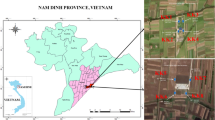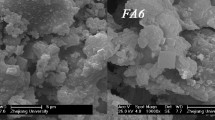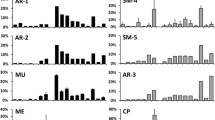Abstract
In this study, we propose an analytical method to determine the fourteen of azaarenes present in flue gas samples collected according to Japanese Industrial Standard K 0311, which designates the method for the determination of dioxins in flue gas. Azaarenes can be analyzed using the acidic water phase after shaking extraction with dichloromethane, which is unnecessary for dioxin analysis. Flue gas samples were obtained from 24 waste incinerators in Japan, and azaarenes were detected in all the flue gas samples (0.21–3800 μg/m3N). The most abundant of the detected compounds were quinoline and isoquinoline. The concentration of azaarenes had a tendency to increase with that of polychlorinated dibenzo-p-dioxins and dibenzofurans. The isomer distribution of heptachloro-dibenzofurans (HpCDFs) was calculated using the computed Gibbs energy of formation (ΔGf) obtained by the semiempirical molecular orbital method at various temperatures. The calculated isomer distribution was fitted to the measured value of HpCDFs. It seems that the temperature obtained from the fitting calculations is an indicator of the cooling capacity of the combustion gas in an incinerator. The computed ΔGf also explained the measured isomer distributions of azaarenes. It is suggested that the isomer distribution of azaarenes in the combustion process is thermodynamically controlled.
Similar content being viewed by others
References
Hirao K, Shinohara Y, Tsuda H, Fukushima S, Takahashi M (1976) Carcinogenic activity of quinoline on rat liver. Cancer Res 36:329–335
LaVoie EJ, Dolan S, Little P, Wang CX, Sugie S, Rivenson A (1988) Carcinogenicity of quinoline, 4- and 8-methylquinoline and benzoquinolines in newborn mice and rats. Food Chem Toxicol 26:625–629
Hashimoto T, Negishi T, Namba T, Hayakawa S, Hayatsu H (1979) Mutagenicity of quinoline derivatives and analogs — quinoxaline 1,4-dioxide is a potent mutagen. Chem Pharm Bull 27:1954–1956
Dong MW, Locke DC, Hoffmann D (1977) Characterization of aza-arenes in basic organic portion of suspended particulate matter. Environ Sci Technol 11:612–618
Adams J, Atlas EL, Giam CS (1982) Ultratrace determination of vapor-phase nitrogen heterocyclic bases in ambient air. Anal Chem 54:1515–1518
Spitzer T, Dannecker W (1984) Clean-up of polynuclear aromatic hydrocarbons and 3-ring azaarenes and their GC-analysis on whisker-walled open tubular columns. J High Res Chromatogr Chromatogr Commun 7:301–305
Yamauchi T, Handa T (1987) Characterization of aza heterocyclic hydrocarbons in urban atmospheric particulate matter. Environ Sci Technol 21:1177–1181
Warzecha L (1993) Separation and analysis of azaarenes from Upper Silesia airborne particulate matter. Chem Anal (Warsaw) 38:571–583
Chen HY, Preston MR (2004) Measurement of semi-volatile azaarenes in airborne particulate and vapor phases. Anal Chim Acta 501:71–78
Wakeham SG (1979) Azaarenes in recent lake sediments. Environ Sci Technol 13:1118–1123
Furlong ET, Carpenter R (1982) Azaarenes in Puget Sound sediments. Geochim Cosmochim Acta 46:1385–1396
Shinohara R, Kido A, Okamoto Y, Takeshita R (1983) Determination of trace azaarenes in water by gas chromatography and gas chromatography-mass spectrometry. J Chromatogr 256:81–91
Sawicki E, Meeker JE, Morgan MJ (1965) The quantitative composition of air pollution source effluents in terms of aza heterocyclic compounds and polynuclear aromatic hydrocarbons. Int J Wat Poll 9:291–298
Sawicki E, Meeker JE, Morgan MJ (1965) Polynuclear aza compounds in automotive exhaust. Arch Environ Health 11:773–775
Handa T, Yamauchi T, Sawai K, Yamamura T, Koseki Y, Ishii T (1984) In situ emission levels of carcinogenic and mutagenic compounds from diesel and gasoline engine vehicles on an expressway. Environ Sci Technol 18:895–902
Rogge WF, Hildemann LM, Mazurek MA, Cass GR (1993) Sources of fine organic aerosol. 5. Natural gas home appliances. Environ Sci Technol 27:2736–2744
Benestad C, Jebens A, Tveten G (1987) Emission of organic micropollutants from waste incineration. Chemosphere 16:813–820
Unsworth JF, Dorans H (1993) Thermodynamic data for dioxins from molecular modelling computations: prediction of equilibrium isomer composition. Chemosphere 27:351–358
Tan P, Hurtado I, Neuschütz D (2002) Predictions for isomer distributions of toxic dioxins and furans in selected industrial combustion processes. Chemosphere 46:1287–1292
Katami T, Ohno N, Yasuhara A, Shibamoto T (2000) Formation of dioxins from sodium chloride-impregnated newspapers by combustion. Bull Environ Contam Toxicol 64:372–376
Yasuhara A, Katami T, Okuda T, Ohno N, Shibamoto T (2001) Formation of dioxins during the combustion of newspapers in the presence of sodium chloride and poly(vinyl chloride). Environ Sci Technol 35:1373–1378
Noma Y, Ishikawa Y, Nose K, Minetomatsu K, Takigami H, Sakai S, Izumisawa S, Kaburaki Y (2004) Chemical characterization of PCBs and dioxins in the waste PCB stockpiles (in Japanese with English summary). J Environ Chem 14:501–518
Masunaga S, Takasuga T, Nakanishi J (2001) Dioxin and dioxinlike PCB impurities in some Japanese agrochemical formulations. Chemosphere 44:873–885
Shin D, Choi S, Oh JE, Chang YS (1999) Evaluation of polychlorinated dibenzo-p-dioxin/dibenzofuran (PCDD/F) emission in municipal solid waste incinerators. Environ Sci Technol 33: 2657–2666
Vogg H, Stieglitz L (1986) Thermal behavior of PCDD/PCDF in fly ash from municipal incinerators. Chemosphere 15:1317–1378
Author information
Authors and Affiliations
Corresponding author
Additional information
This work was presented in part at the International Conference on Combustion, Incineration/Pyrolysis, and Emission Control, 2006, Kyoto
Rights and permissions
About this article
Cite this article
Minomo, K., Ohtsuka, N., Nojiri, K. et al. Characteristics of azaarenes and dioxins in gases emitted from waste incinerators. J Mater Cycles Waste Manag 11, 73–81 (2009). https://doi.org/10.1007/s10163-008-0221-5
Received:
Accepted:
Published:
Issue Date:
DOI: https://doi.org/10.1007/s10163-008-0221-5




